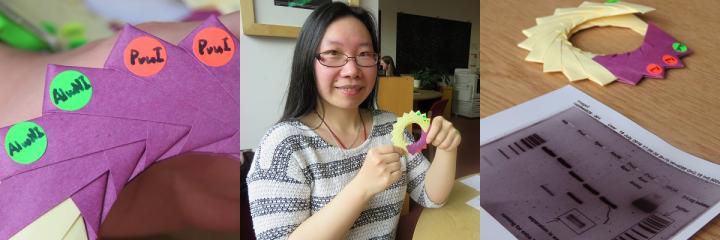Cass Li and the art of origami in public engagement
In the first of our series focusing on public engagement by the Deanery of Biomedical Sciences, Cass Li talks about how she uses origami to help students to understand plasmids.

Research
I’m currently working on the development of the thalamus, especially how cells that look quite similar to each other gradually give rise to different group of cells that have distinct physiological functions.
The idea
I was teaching two S5 students, a boy and a girl, about a commonly used technique in the lab called restriction digest. At the beginning, I talked them through the applications of the technique in daily research, the core concepts involved in the technique and the protocol used for the digest experiment I was to do with them. Then I gave them each a set of origami plasmids with digestion sites labelled according to the experiment and asked them to dissemble the origami at the given sites and look at the size of the resulted fragments. That allowed them to predict the result of the experiment before we actually performed it. After that, I performed the digest following by an electrophoresis to confirm the size of the fragments and students were able to confirm their predictions by looking at the real result.
The idea I was trying to convey is that simple techniques in biology can be applied to solve a lot of real life problems and understanding the concepts and principles is fundamental to good use of them.
Why origami?
I am a big fan of origami. I played with a lot of origami when I was very little and I’m still making them nowadays. The best thing about origami is that it is especially useful for making models of tiny things that human eyes wouldn’t be able to resolve like the plasmids. Origami is easy to make, flexible and it adds a lot of fun to studying. Besides, the students were not allowed to do any experiments during the visit so the origami served very well as a compromise.
A tactile prop
I found that quite a few past undergrad students got stuck on the digestion problem because it’s difficult to establish the structures in their mind. When they actually looked at the origami plasmids, dissembled and reassembled it, they got it very quickly. The origami definitely helps the students to understand the subject better. Things are easier when you can see unassisted, and even better if you can actually play and experiment.
Top tips for running a workshop
- Come prepared. Pre-run the workshop, (in my situation the experiment) and keep an eye on the time.
- Get the attendees interested in the workshop from the very beginning.
- Ask questions to get instant feedback from the attendees and modify the content of the workshop accordingly if necessary. For example, you can invite students to try challenging problems and if they are reluctant then try to figure out whether they have difficulties understanding the content and give them some help.
Words of wisdom for young students
Science is fun, come and play!
Outreach and public engagement at the Deanery of Biomedical Sciences
Read more about our work running workshops and bringing science to diverse audiences

